|

Our French Courses in Switzerland click below :
- Geneva
Population 7,2 millions
 National Anthem National Anthem
German (official) 63.7%,
French (official) 19.2%,
Italian (official) 7.6%,
Romansch 0.6%,
other 8.9%
History
1291: The 3 states Uri, Schwyz and Unterwalden - the so called "Ur-Kantone" unite against the surrounding aggressors. A citizen of each state swears on august, 1st 1291 on a small mountain named "Rütli":
"we will be a one and only nation of brothers ..."
This leads to the term confederation ("Eidgenossenschaft")
1332: Luzern joins the Swiss Federation
1351: Zürich joins the Swiss Federation
1352: Glarus and Zug join the Swiss Federation
1353: Bern joins the Swiss Federation - 8 states form the acht alten Orte ("eight old states")
1460: Foundation of the first university of Switzerland at Basel
1481: Fribourg and Solothurn join the Swiss Federation
1500: Beginning of a new area called "Renaissance", people become interested in science.
1501: Basel and Schaffhausen join the Swiss Federation
1513: Appenzell joins the Swiss Federation
1522: Beginning of the "Reformation"
1648: Declaration of Independence - Switzerland becomes an independant Nation
1803: Sankt Gallen, Graubünden, Thurgau, Ticino, Aargau and Vaud join the Swiss Federation
1812: The Swiss Federation declares its neutrality.
1815: Valais, Neuchâtel and Genéve join the Swiss Federation - Switzerland gets its final boundaries
1848: The Swiss Federation changes from a Union of States to a Confederation. Its first Federal Constitution ("Bundesverfassung") is set up.
1864: Foundation of the International Red Cross(IKRK).
1872: Start of the construction of the railway across the alps ("Gotthardbahn").
1882: Opening of the "Gotthardbahn".
1932: Swiss physician Auguste Piccard sets record when he reaches a height of 16'940 m with his balloon. This was the first ballon equipped with a preassure cabin.
1960: Jacques Piccard (son of Auguste Piccard mentioned above) sets record when he dives together with american Don Walsh in a Bathyscaphe (special type of submarine) called "Trieste" as low as 10'916 m below sea level.
1971: Swiss people vote for the women's suffrage.
1978: Some villages leave the state Bern and found the new state Jura
2-oct-1984: The combined federal assembly ("Vereinigte Bundesversammlung") elected Elisabeth Kopp as the first woman as Bunderat (executive authority). Ms. Kopp had to step back on 12.1.1989 due to some possible illegal activities of her husband.
1992: Swiss people vote against becoming a member of the EEA (european economic area)
31-jul-1992: Claude Nicollier (born 2-sep-1944) takes off on board of the space shuttle Atlantis (ST-46) and becomes the first Swiss in space.
10-mar-1993: The combined federal assembly ("Vereinigte Bundesversammlung")
elected Ruth Dreifuss as the second woman as Bunderat (executive authority).
2-dec-1993: Claude Nicollier's second journey on board of a space shuttle.
The mission of Endeavour (STS-61) is seen as the most difficult one so far, the repair of the Hubble space telescope. It is Claude Nicollier's task to catch the telescope with the robotic arm of the space shuttle.
1999: Ruth Dreifuss became the first female president of the Bundesrat ("Bundesratspräsident").
11-mar-1999: The combined federal assembly ("Vereinigte Bundesversammlung")
elected Ruth Metzler as the third woman as Bunderat (executive authority).
Ruth Metzler is 34 years young !
20-mar-1999: Swiss Scientist Bertrand Piccard (son of Jacques Piccard mentioned above) and british co-pilot Brian Jones have become the first balloonists to circumnavigate the globe with a non-stop, non-refuelled flight. It has taken the team 19 days, 21 hour and 55 minutes to travel the 46'759 km on board of Breitling-Orbiter 3.
18-apr-1999: Swiss people accept a new Federal Constitution ("Bundesverfassung") on a vote.
21-may-2000: The Swiss people accept the bilateral contracts with the European Union
1 Swiss franc, franken, or franco (SFR) = 100 centimes, rappen, or centesimi
Travel information and advisory reports . For nationals of other countries, please address yourself to the embassy or the consulate of Switzerland in your own country.
 

Swiss Chocolate Mousse
Ingredients:
4 oz. Swiss Chocolate
5 Eggs
5 oz. Sugar
10 oz. Heavy Cream
Preparation
-
Whip heavy cream until it stands in a peak. Refrigerate.
-
Combine two eggs, three egg yolks and sugar in a stainless bowl and whisk till the mixture stands to a peak.
-
Melt chocolate over a double boiler (not warmer than body temperature)
-
Blend all the egg/sugar mixture with the melted chocolate a little at a time.
-
Fold in whipped cream, reserving four spoonfuls for garnish.
-
Add chopped nuts or chocolate chips if you desire.
-
Fill in serving dishes and refrigerate for 2 hours before serving.
|
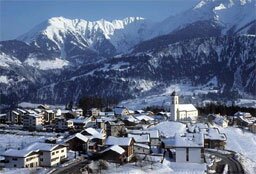 Switzerland is bordered by France to the west, Germany to the north, Austria to the east and Italy to the south. It has the highest mountains in Europe, with waterfalls and lakes set amid green pastures. The highest peaks are Dufour Peak, 4634m (15,217ft), on the Italian border; the Dom, 4545m (14,912ft); the Matterhorn, 4478m (14,692ft); and the Jungfrau, 4166m (13,669ft). Switzerland is bordered by France to the west, Germany to the north, Austria to the east and Italy to the south. It has the highest mountains in Europe, with waterfalls and lakes set amid green pastures. The highest peaks are Dufour Peak, 4634m (15,217ft), on the Italian border; the Dom, 4545m (14,912ft); the Matterhorn, 4478m (14,692ft); and the Jungfrau, 4166m (13,669ft).
Swiss towns never lose their appeal - whatever the time of year! Art, culture and culinary delights abound in Swiss towns. And if shopping is your particular love, the opportunities are practically limitless. Add to this the many events which are held throughout the year: carnivals in spring, open-air festivals in summer, wine growing festivals in autumn and Christmas market fairs in winter. Each Swiss town is also individual in character due to its history, its unique buildings and the people who live in them.
Being such a mountainous country, it is only a short excursion from any Swiss town into the Alps. Extensive diversity within a small area - this best describes the charm of Swiss towns. It's well worth while paying a visit to Swiss towns - for a weekend, or even a few days longer.

Bern (founded 1191) is one of the few mediaeval cities which has been preserved intact and in its entirety.
Because of this, UNESCO has placed Berne on its list of Word Cultural Heritage, among such world-famous sights as the Pyramids of Egypt, the Taj Mahal and the centres of Rome and Florence. It is the only Swiss city which as a whole is honored in this way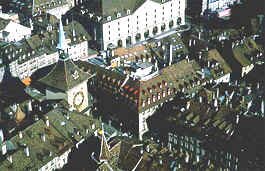 .Awarded the title of "Europe's most beautiful floral city", Berne is a friendly city where you'll soon feel at home. .Awarded the title of "Europe's most beautiful floral city", Berne is a friendly city where you'll soon feel at home.
It is also off the beaten "tourist track". 3000 hotel beds. 300'000 inhabitants. Here you can still encounter native Bernese. The sloping streets of the Aare peninsula offer visitors everything they could want within a compact area: hotels, over 150 restaurants, a 4 miles/6 kilometer long shopping promenade, interesting sights, entertainment and convention facilities. A glance is all you need to convince yourself of Berne's ideal situation. Berne's favorable location for international rail, road and air connections allows you to travel with ease and gives you the unique advantage of being able to discover practically the whole of Switzerland without having to constantly pack and unpack. Berne is on the UNESCO list of World Heritage Sites and the Old Town is a popular meeting-place for the city's residents. Shopping in Berne is more than just a spending spree - it is a genuine experience.
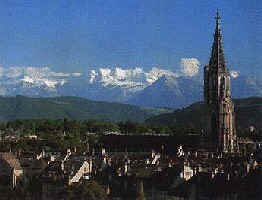
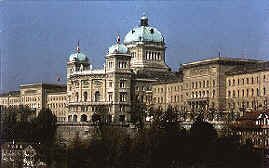
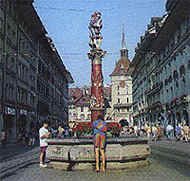 Did you know...? Did you know...?
That Einstein lived in Berne and developed his theory of relativity here? That the largest collection of Paul Klee's works is housed in Berne's Museum of Fine Art? That the world-famous Toblerone chocolate is made here?
That the solar sail for American moon missions was designed at the University of Berne? That the largest stamp collection on view to the public can be seen at the Swiss Postal Museum?
What to see and what to do
Here a list of excursions you'll be able to make while visiting this small but so divers country:
Gruyeres:
This excursion takes you to the mediaeval village of Gruyères, perched on top of a hill - a picturesque gem in the middle of rural Fribourg. The castle, dating from the 13th century, is open to the public and tourists will also admire the late Gothic houses lining the village's main street. The modern working dairy, where the famous Gruyère cheese is made, is also worth a visit, and the cheese and other dairy products can be tasted.
Emmental Tour
A tour through the Emmental, via Moosegg, to Lueg, a vantage point offering a splendid panorama of the Alps and the rolling hills of the Emme Valley (Emmental). This is where the world-famous cheese, with its well-known holes, is made. A dairy can be visited where the cheese can be sampled.
Photo Safari through Mediaval Market Towns
This tour takes in the mediaeval market towns of Aarberg (built round its large market square), Erlach (11th century), Le Landeron, La Neuveville (with the famous "Rue du Marché"), Ligerz (a picturesque vineyard village), and Büren an der Aare. Visitors can also call in at a wine cellar on Lake Bienne if they wish. Traveling time: 2 ½ hours.
Lake Geneva
This is a tour into the French-speaking part of Switzerland. The route leads via the mediaeval market towns of Murten, Payerne and Moudon to the Swiss Riviera, as this area is often called. From Lausanne-Ouchy visitors take a boat to Montreux. Visit to the 12th century castle of Chillon. The return journey leads through the vineyards high above the lake along the famous "Corniche" road to Bulle and Fribourg.
And many many more.....
|

